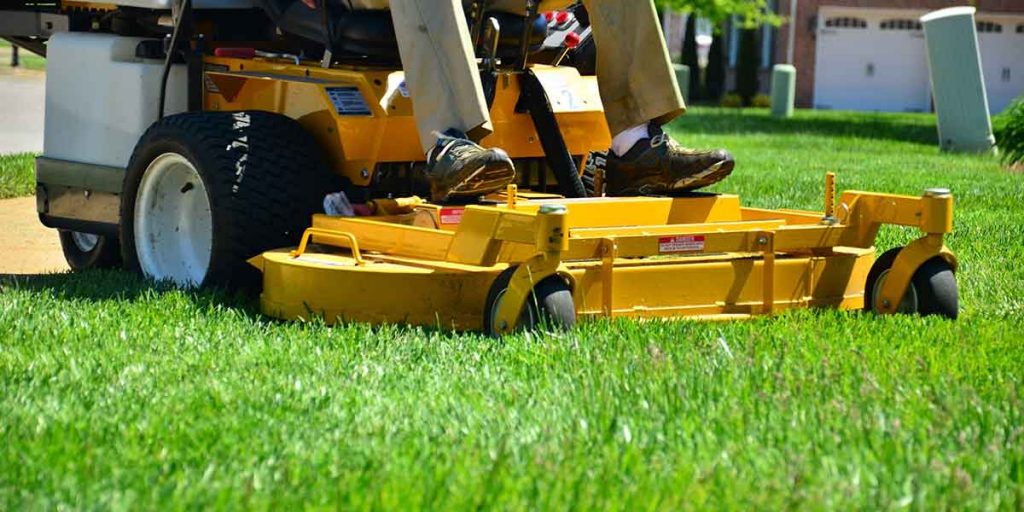
Now that warmer weather is on the way, many commercial property owners like yourself are getting ready to roll out their landscaping and grounds management plans for the year. You may wonder how often the lawn needs to be mowed to keep your property looking great while keeping costs down. The general rule of thumb is to mow once every week or two, but that is a little too vague to maximize your lawn’s appearance.
Assessing the Best Mowing Schedule for Your Property
In order to build an effective mowing schedule, several factors need to be taken into consideration. It’s important to make sure all of these factors work together in order to come up with the best lawn care plan for your property.
Here are some things to think about when determining an effective schedule to keep your lawn looking its best:
Time of Year
There are two main categories of grasses: cool-season and warm-season. Cool-season grasses grow faster in the spring and fall. These are better suited for regions with colder winters such as the Midwest, the Northeast, and the Pacific Northwest. Warm-season grasses, on the other hand, grow faster during the warmer months of the year. These generally thrive in regions like the Southern US and Southern California. The grass needs to be mowed more often during these growing seasons than the “off-seasons”.
The Amount of Watering or Rainfall (and Fertilizer)
How often you water and fertilize your grass (and how often it rains) also affects your mowing schedule. More frequent watering and fertilizing (and more rainfall) usually means more mowing. Make sure that your lawn is receiving enough water and fertilizer to stay healthy and vibrant, and also avoid overwatering. Grass should always have enough time to dry before mowing. Very wet grass clumps together, which causes more stress on mower blades and engines. Wet grass also doesn’t cut very evenly. Ungathered wet grass clippings can also trap moisture underneath, leading to mold and diseases in your grass.
The 1/3rd Rule
When cutting grass, the general rule is that you should never cut more than 1/3 of its overall length. For example, if your grass is 4-1/2″ tall you should cut 1-1/2″ at most, leaving it at 3″. Cutting too much grass at one time removes the grass’s food-producing parts. This can essentially starve your lawn and turn it yellow or brown. If you want the grass shorter than that, the next time you cut it you should only remove 1″ (1/3 of 3″) from it at most. If needed, mow the lawn on a regular basis until the desired height is achieved, but make sure to only cut 1/3 of the overall length at a time.
Optimal Lawn Height

One thing people may not realize is that different types of grass have different recommended heights. Cutting grass too short can lead to weak roots, dead patches, or other issues. Waiting until the grass is very long and then cutting it can also damage it because this can shock the root system. Long grass also creates a larger amount of grass clippings that need to be bagged or mulched. Mulching your grass clippings is recommendable, as it helps to return water and vital nutrients to your lawn, reducing the amount of fertilizer your lawn needs.
Here are the recommended heights for some of the most common grasses in the US:
Cool-season grasses
- Kentucky Bluegrass: 1-3/4″ to 2-1/2″
- Fescue Grass: 1-1/2″ to 2-1/2″ for Fine Fescue, 2” to 3” for Tall Fescue
- Ryegrass: 1-1/2″ to 2”
Warm-season grasses
- Bahia Grass: 2” to 3”
- Bermuda Grass: 3/4″ to 1-1/2″ for Common Bermuda, 1/2″ to 1” for Hybrid Bermuda
- Zoysia Grass: 1” to 2”
Experienced Landscaping & Maintenance
Ensuring your grass is healthy and green all year long will work wonders on the appeal and overall value of your property. For over 25 years, GroundMasters Landscape Service has been helping our Denver metro area clients with all of their landscape maintenance and enhancement services. In addition to lawn care, we offer tree and shrub care, water maintenance, and even snow and ice removal services for year-round care.
If you are looking for a dependable, knowledgeable, and professional landscape management service, please give us a call at (303) 750-8867 or contact us online today to get started.
We help property owners across the Denver the entire metro area including Greenwood Village, Centennial and Lone Tree.
